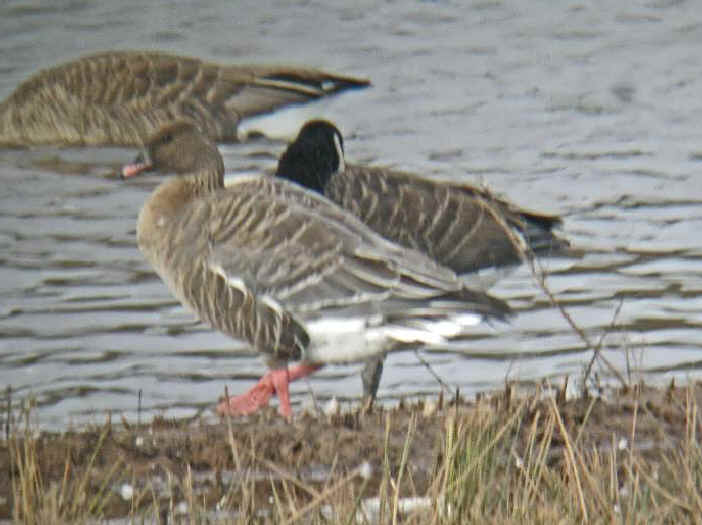The BIRDLINE by ARMAS HILL
With
Geese: Pink-footed, Greenland White-fronted, & Barnacle and other
birds too
Armas Hill has presented the "Birdline", originally from
Philadelphia, on the phone and internet for over 3 decades, and on the radio
in Delaware for about 10 years.
Links:
A
List & Photo Gallery of North American Birds, in 6 Parts
A
List & Photo Gallery of North American Mammals


The pink feet of the
Pink-footed Goose
in Bucks County, Pennsylvania,
referred to in the text below.
The Birdline
for December 1, 2011:
There is a book
entitled "The Search for the PINK-HEADED DUCK", by Rory
Nugent. It's a good read, published in 1991, about a journey into the
Himalayas, and down the Brahmaputra, in search of, well, you know.
No, that bird was not found, but truly there were enough notable
experiences to fill a good book. The last reliable sighting of the
PINK-HEADED DUCK was in 1935.
Well, we have no report of a PINK-HEADED DUCK here, but we do have another
one of a PINK-FOOTED GOOSE.
Last time, a PINK-FOOTED GOOSE was reported as being in Middletown, New
York.
This week there has been one on Bucks County, Pennsylvania,
north of Doylestown, at the Pine Run Reservoir. Found there on
November 28, it has continued to be seen, at various times, thru today,
December 1.
Most of the PINK-FOOTED GEESE in the world nest in the highlands of Iceland.
A few also nest in eastern Greenland. Those PINK-FOOTED
GEESE, that breed in Iceland & Greenland, winter in Scotland and
northern England.
A separate population breeds in Svalbard. Those birds winter
from Denmark to Belgium.
But, as noted, most breed in Iceland, where in the highlands, there is
one of the largest goose colonies in the world, with an estimated 10,000
pairs of PINK-FOOTED GEESE. And there are other, smaller colonies that
exist elsewhere in the high country of Iceland.
In recent years, in both Iceland & Greenland, the population of
the PINK-FOOTED GOOSE has been increasing. In fact, in recent decades, the
total population of the species in the autumn has increased from about
23,000 birds in the 1950s to about 230,000 in the 1990s. That's a
10-fold increase, and the population has continued to rise since.
A GREATER WHITE-FRONTED GOOSE, of the Greenland race, was seen in
Chester County, Pennsylvania, in Landenberg at Somerset
Lake, on November 27.
Another GREATER WHITE-FRONTED GOOSE has been in Pennsylvania in
Lehigh County, at Dorney Pond.
A BARNACLE GOOSE has been in West Newbury, Massachusetts. A
few other species of GEESE will be noted here in a moment.
The 3 species of GEESE just mentioned, the PINK-FOOTED, the GREATER
WHITE-FRONTED, and the BARNACLE, all occur in Iceland.
To read more about them there, here's a link: http://www.focusonnature.com/IcelandBirdListIceland.htm
West Newbury, in Massachusetts was just mentioned.
Another notable bird there recently has been a CASSIN'S KINGBIRD, the
4th record of that western North American species in Massachusetts. Found
on November 25, and present thru at least November 28, it was seen
during that time by hundreds of birders.
Whereas the BROWN BOOBY that was at Cape May, New Jersey, departed there by
the beginning of November, the juvenile BROWN BOOBY in Massachusetts,
continued periodically thru the month, at the Provincetown Harbor.
In Eastham, Massachusetts, an ASH-THROATED FLYCATCHER has continued, and
a female PAINTED BUNTING has been seen lately.
Last time, on the Birdline, a name of a bird was inadvertently omitted.
The "tiny hummingbird from western North America that continued in
the East, in Maryland" was a CALLIOPE
HUMMINGBIRD, that has continued since, as of at least November 28.
Now, a bit more about some GEESE:
A single ROSS' GOOSE has been in Brooklyn, New York.
Seen on November 27 by the Floyd Bennett Field, with 17 CANADA GOOSE. Now,
that's a "goose-chase" that's easily do-able, if the birds are
there!
Another ROSS' GOOSE has been, lately, at Brigantine Refuge in New
Jersey, among thousands of SNOW GEESE.
In Pennsylvania, as many as 12 CACKLING GEESE have been observed
in Northampton County, at Green Pond, along with mostly CANADA
GEESE, and some SNOW GEESE, and also a SANDHILL CRANE that has now been
at that spot for more than 4 months.
Last time, on the Birdline, a number of notable birds were told of
in one Pennsylvania county: Berks. A
GREEN-TAILED TOWHEE, a juvenile WHITE IBIS, and 2 SANDHILL CRANES were
noted.
The TOWHEE, at the Blue Marsh, and the IBIS, in Hamburg, have
continued, at least as of November 30. And what was probably 1 of the 2
SANDHILL CRANES was at the Breneman's Quarry on November 27.
But add to the Berks County mix, a HARRIS' SPARROW that's been just west
of Kempton (near Hawk Mountain Sanctuary), found on November 27 and
present thru at least November 30.
Elsewhere in Pennsylvania, a VARIED THRUSH was seen in Huntingdon
County, on November 26, in pines near Masseyburg.
And a PRAIRIE FALCON has returned to Cumberland County, Pennsylvania,
for the 6th consecutive year, in the area of Mud Level Road and Britton
Road.
Along the seacoast of New Jersey in eastern North
America, at Barnegat Light, a WESTERN TANAGER was present from
November 26 to 28. Another westerner, an ASH-THROATED FLYCATCHER was
found there on November 26.
Elsewhere in New Jersey, an ASH-THROATED FLYCATCHER was seen on November
26 at Ramapo Mountain.
Also in the area of Barnegat Light, recently, in addition to the
just-mentioned tanager and flycatcher: BALTIMORE ORIOLE, YELLOW-BREASTED
CHAT, ROSE-BREASTED GROSBEAK, a large flock of COMMON EIDERS (a few
hundred), among them 1 female KING EIDER, about 20 HARLEQUIN DUCKS, PARASITIC
JAEGERS, a few hundred BONAPARTE'S GULLS, a LITTLE GULL, a BLACK-HEADED
GULL, and a 2nd-year GLAUCOUS GULL.
A NORTHERN SHRIKE was recently seen in southern New Jersey,
in Cumberland County, along Thompson's Beach Road, on November 27.
Another NORTHERN SHRIKE was seen again today, December 1, in Pennsylvania,
at Tinicum Refuge, near the Philadelphia Airport.
A LOGGERHEAD SHRIKE was seen, this past week, in Maryland,
November 28 & 29, near Hagerstown.
A belated report: a SAY'S PHOEBE, of the western US, was in New
York, at the Coxsackie Grasslands on November 19.
Last time, it was noted here that there's an influx of SNOWY OWLS
south into the United States. One, in New Jersey, at
the Merrill Creek Reservoir, has continued, as of at least November 26.
One was seen and photographed in Staten Island, New York
City, on November 29, near the Verrazano Narrows, by Hoffman
Island, at the entrance to the New York Harbor.
A state with a nice, large number of SNOWY OWLS has been Wisconsin,
with close to 20 individuals.
A city where there have been 2 SNOWY OWLS is Ashtabula, Ohio,
where also a BLACK-TAILED GULL was seen on November 26.
The BLACK-TAILED GULL is a bird of Asia, especially Japan.
In the last Birdline, reference was made to some wandering birds,
including a RUFOUS HUMMINGBIRD in eastern Pennsylvania
that was banded in January 2011 in Louisiana (that bird
still in Pennsylvania this week), a GREAT EGRET with a
band in Delaware, from Ontario, and
the continuing story that we've been giving of OSPREYS with radio
transmitters, mostly now in South America.
Here, in conclusion, this time, mention is made of an AMERICAN KESTREL
that was banded, as a chick, at a nest box on July 4, 2010, in Pennsylvania,
in Lehigh County, in Grimville (I wish the name were more uplifting).
But it is of interest that the same banded bird was captured this past
week, on November 26, in Punta Gorda, Florida. One
smart bird, not so much that it was caught, but because it's
spending December in Florida!
And just as the OSPREYS, mentioned a moment ago, are being tracked
with transmitters, so are COMMON CUCKOOS, that were in England,
and are now in Africa.
After 3 months in Nigeria, one has joined the other 4
CUCKOOS in the Congo Rainforest - now, the closest that
these COMMON CUCKOOS have been to each other since leaving East
Anglia in the UK, this past summer.
Armas Hill has presented the Birdline, originally fro
Philadelphia, on the phone and internet for decades (3), and on the
radio in Delaware for years (10).
The Birdline (and the Natureline) are
affiliates of Focus On Nature Tours.
This Birdline began by referring to the PINK-HEADED DUCK.
It will be the beautiful PINK-HEADED WARBLER that will be seen during
upcoming FONT tours in the highlands and lowlands of Guatemala.
There is still some availability on the upcoming FONT Guatemala
tour, March 27 to April 8, 2012.
With of course not just the PINK-HEADED WARBLER, but also many
other birds, among them: up to 6 species of MOTMOTS, plus
TOUCANS, TROGONS, TANAGERS, and TITYRAS, and some specialty birds such
as the HORNED GUAN, RESPLENDENT QUETZAL, AGAMI HERON, ORANGE-BREASTED
FALCON, SPARKLING-TAILED COQUETTE, AZURE-RUMPED TANAGER, and PHEASANT
CUCKOO.
Information about this, and other upcoming FONT tours, is in the website: www.focusonnature.com
To
Top of Page


